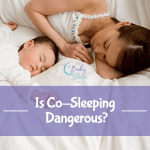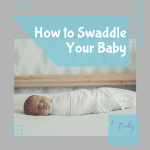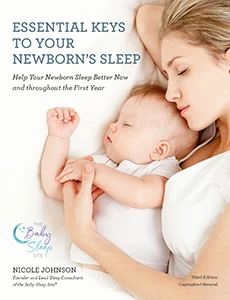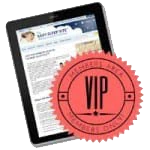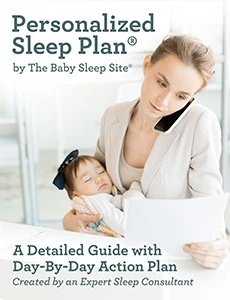
We’ve always recommended swaddling as a good (and safe) way to help soothe fussy newborns and to promote better baby naps and longer nighttime sleep. But, do we need to rethink our position on swaddling babies? At this point, many daycares have banned swaddling and the American Academy of Pediatrics has labeled swaddling an “unsafe” practice in childcare settings. In fact, it’s illegal for childcare centers in Minnesota to swaddle at all!
Why Are Daycares Banning Swaddling, and How Is It Affecting Babies?
So, what’s prompted this recent ban on swaddling? In 2011, a study by the National Resource Center on Child and Health Safety (NRC) and the American Academy of Pediatrics (AAP) concluded that swaddling can increase the risks of “serious health outcomes” and concluded that “swaddling is not necessary or recommended” in any childcare setting.
The AAP named several specific swaddling-related concerns, including:
- Hip dysplasia or dislocation (tight swaddling increases the chances of hip problems.)
- Loose blankets in the crib. (If a baby breaks free of the swaddle, the blanket can cover his face, increasing the risk of SIDS.)
- Stomach sleeping. (If a swaddled baby is placed on her stomach to sleep, or if she rolls from her back to her stomach while swaddled, it increases the risk of SIDS.)
- Improper swaddling technique in general. (The AAP has concerns that not all childcare workers know how to safely swaddle babies.)
As you can imagine, this recent push to stop swaddling newborns and young infants has made a major impact on childcare providers. Daycare providers report that infants who used to sleep an hour or more at a time are now sleeping for 15-20 minutes (or not at all). This, of course, means there’s far more crying and fussiness for daycare staffers to deal with and lack of sleep isn’t good for the babies, especially! This has parents and caregivers alike feeling very, very frustrated.
Who Doesn’t Support the Ban?
As you know, most newborns need more gentle approaches to help them fall asleep. So what’s a family to do when they have a fussy newborn? We offer newborn-friendly sleep coaching strategies in our e-book, Essential Keys To Your Newborn’s Sleep. We also offer newborn-focused Personalized Sleep Plans® to help your newborn develop healthy sleep habits. But, it’s not as if child care employees can hold and rock every single wailing infant at the same time. Swaddling is likely one of the few methods childcare centers can use to soothe all their babies simultaneously. Unfortunately, a persistent lack of daytime naps isn’t healthy for young babies. It likely means less sleep at night, too. (The over-tiredness brought about by poor naps directly affects nighttime sleep.)
However, if not done properly, swaddling can create issues (some of them serious). Swaddle a baby too loosely, and she’s likely to kick off her blanket. And loose blankets in the crib? A big no-no. Swaddle a baby too tightly, though, and you risk causing hip dysplasia or dislocation.
And there’s another big risk:
A baby who’s snugly swaddled may still be able to roll over, from his back to his stomach. And a baby who’s swaddled and lying on his stomach is at an increased risk for suffocation.
The American Academy of Pediatrics may support the ban on swaddling in childcare centers, but not every baby expert agrees with this approach. Dr. Harvey Karp, the creator of the Happiest Baby on the Block books and DVDs, and an avid proponent of swaddling, has spoken out against this recent trend. He emphasizes that swaddling is an ancient and universally-used technique. He points out that, in his opinion, the NRC hasn’t met the “burden of proof” they need to in order to issue such a sweeping recommendation. In their 2011 report, the NRC listed only five studies as references, and ignored the huge body of literature that highlights the benefits of swaddling. There have been others who have spoken out against the ban such as here.
But, does this mean you should ignore the NRC and AAP recommendations?
Should You Still Swaddle Your Baby? Safe Swaddling Tips and Techniques
It appears there’s always a study coming out showing something is unsafe that was once safe. It’s hard to keep up with it all! As with many “recommendations,” each family needs to weigh the pros and cons, make an educated decision, and do what’s best for their own baby and situation. This is true of many decisions you will need to make with your baby. For now, we wanted to share safe swaddling tips should you choose to swaddle your baby.
- NEVER PUT/ALLOW A SWADDLED BABY TO SLEEP ON HIS STOMACH: Swaddled babies should be laid down on their backs, and should sleep that way. Putting or allowing a baby to sleep on his stomach while swaddled increases the risk of SIDS and is not safe.
- DO NOT SWADDLE TOO TIGHTLY: When you swaddle your baby, you may feel tempted to wrap him up as tightly as possible. Avoid that impulse, though. Babies who are wrapped too tightly may not be able to breathe well, and wrapping their legs too tightly can lead to hip dysplasia and dislocation. A baby’s legs should always be able to bend freely in the swaddle. Bottom line… Babies should be wrapped snugly, but not tightly, in a light and breathable blanket. Note: Nicole used the Miracle Blanket with both her boys.
- CHOOSE ARM/HAND POSITION: Historically, parents have swaddled babies with their arms by their sides. Recently, however, there’s been a push to swaddle babies with their hands by their faces. Supporters of this technique point out that it allows babies to self-soothe, by sucking on their fingers. They also point out that it gives baby a bit more mobility. This means that if baby does accidentally roll over while swaddled, she can do something about it. However, not everyone agrees.
In an interview with Nicole, Dr. Karp explained that he still advocates for swaddling with arms by the sides. He shared that after the first few weeks of life, arms begin to relax and it’s more comfortable for most babies to have hands by the sides. “If babies’ hands are by their faces, they’re less likely to soothe themselves and more likely to hit/scratch themselves in the face.” He also said that a baby who’s swaddled with hands up is far more likely to break free of the swaddle. All babies are different. Listen to your baby’s cues about what is most comfortable. If you swaddle with arms by sides, be sure to leave flexion in the elbows. Your baby’s arms shouldn’t be rigidly straight. If you swaddle with hands by face, check on baby regularly, to be sure she hasn’t broken free of the swaddle or loosened the blanket.
- SUPERVISE YOUR BABY: To be completely safe, you should supervise your baby while he’s swaddled. That way, if the blankets come loose, or if he rolls over, you’re there to intervene. Many families of newborns tend to room share for closer monitoring.
If you’re practicing safe swaddling techniques (using light cotton blankets, swaddling snugly but not tightly, etc.), you greatly reduce the risk that anything dangerous can happen to your baby while he’s swaddled. However, to be extra cautious, if you want to swaddle for prolonged periods, invest in a movement monitor. A movement monitor does just what the name says. It monitors your baby’s movements. If your baby is still for too long, an alarm sounds. Movement monitors are designed to combat SIDS. They alert parents (or daycare staffers) to situations in which a baby might not be breathing.
For a demonstration on safe swaddling techniques, check out this video:




